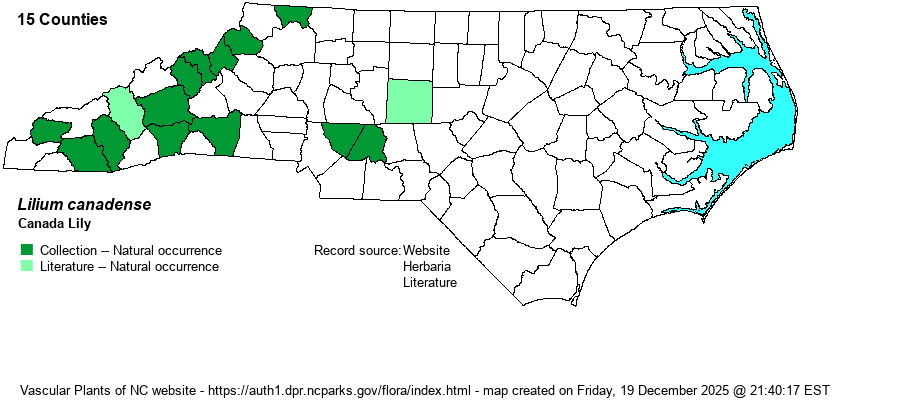| Author | L. | |
| Distribution | Scattered over most of the Mountains, and disjunct to a few sites in the central Piedmont.
This is a northern species that ranges from N.B. to southern Ont., south through NJ, PA, and OH. South of those states it is found mostly in the Appalachian Mountains, south into central NC, northwestern SC, and northern GA and AL. | |
| Abundance | Despite it having been recorded from at least 15 NC counties, this is now a very rare species in the Mountains, and extremely rare in the Piedmont. Though the NC NHP lists 14 records, only about half of these are still extant, and hardly any are of good quality. This is a State Endangered species. | |
| Habitat | This is a lily of damp to wet soil, usually in open to partly open situations. In NC, most are found in bogs or wet meadows. A few records are from open woods or balds, but typically in a semi-wooded setting the plants are in damp ground, such as seepage. |
| Phenology | Blooms in June and July, and fruits from late July into September. | |
| Identification | Species in the genus Lilium are among our most beautiful wildflowers. This is one of the rarest of the group in the state, certainly having declined from 50 years ago due to habitat loss and perhaps other factors. It grows about 3-4 feet tall, with several large flowers (often 3-5) on long stalks from the upper part of the stem. There are 6-10 whorls of leaves along the stem, with 4-12 long and narrow leaves in each whorl. The leaves grow to 4-5 inches long and are widest at or below the middle. The flowers can be deep orange to nearly red, but a second color form has the flowers more yellow than orange. The flowers are 2-3 inches long and hang downward on the long stalks; the 6 tepals (petals and sepals) are notably recurved toward the tip, to give the dangling flowers a "flaring bell" shape. Normally, the widely flaring flowers should be enough for identification, but the globally rare Gray's Lily (L. grayi) can look somewhat like L. canadense. However, L. grayi normally has tepals that are not strongly recurved and thus the floral opening is narrower and the flowers have almost "straight" sides. That species grows at high elevations, on grass balds, seepages, and at a variety of other cool sites, shaded or in the open; it does, however, grow in mountains valleys as well (and thus habitat cannot rule that species out from consideration). Its flowers normally are a deeper red than the orange-red flowers of L. canadense; however, there is some evidence of intergradation between the two, at least in southwestern VA (Weakley 2018). It is highly unlikely you will find a population of L. canadense on your own in the state, and sadly it is on its way out in NC. | |
| Taxonomic Comments | Many or most references do list subspecies or varieties of the species, however there seems to be a more recent trend that those taxa are not valid. NatureServe listed them as subspecies a few years ago, but now it lists only the full species with no taxa within it.
| |
| Other Common Name(s) | Wild Yellow-lily, Meadow Lily | |
| State Rank | S1 | |
| Global Rank | G5 | |
| State Status | E | |
| US Status | | |
| USACE-agcp | FAC link |
| USACE-emp | FAC link |

